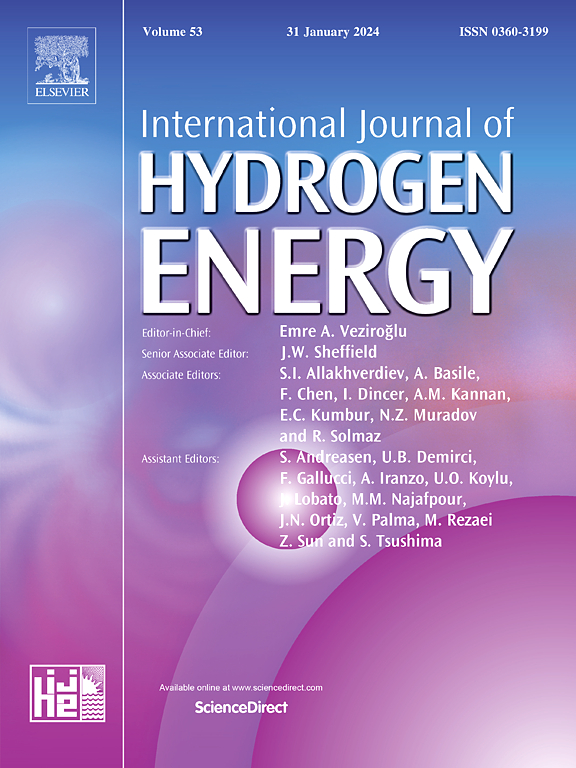Development and thermodynamic analysis of a low-carbon power and synthetic natural gas co-generation plant driven by hybrid biomass-solar energy
IF 8.3
2区 工程技术
Q1 CHEMISTRY, PHYSICAL
引用次数: 0
Abstract
An innovative low-carbon system based on gasification of wood and solar energy is proposed and analyzed for co-generation of power and synthetic natural gas. Produced synthetic fuel can be directly injected into the natural gas grid or utilized as a promising energy carrier in order to save surplus power to overcome the problem of intermittent nature of generated power by solar energy. The integrated system comprises an externally fired gas turbine cycle, a regenerative steam Rankine cycle, an organic Rankine cycle, proton exchange membrane electrolyzer, methane synthesis unit and photovoltaic solar system. Thermodynamic models are developed to evaluate system proficiency from energy, exergy, and environmental perspectives. Synthetic fuel production rate is evaluated in two different scenarios (solar supported and non-solar supported) under five electrolyzer operating loads as green hydrogen route. when 10 % of the power is allocated to produce the hydrogen required for the methanation process, overall exergy efficiency is obtained 39.19 % and 42.12 % for the solar energy scenarios, respectively. In this case, 1021 t/yr CO2 is utilized by the solar supported system to produce 380.5 t/yr synthetic fuel with sustainability index of 1.645 while, 804.7 t/yr CO2 utilized by the non-solar supported system to produce 299.8 t/yr synthetic fuel with sustainability index of 1.728. According to the Sankey diagram, externally fired gas turbine cycle is the primary source of thermodynamic inefficiency, with the gasification unit being the most exergy destructive component.
生物质-太阳能混合能源驱动的低碳电力与合成天然气热电联产装置的开发与热力学分析
提出并分析了一种基于木材和太阳能气化的创新低碳系统,用于电力和合成天然气的热电联产。生产的合成燃料可直接注入天然气电网或作为一种有前景的能源载体加以利用,以节省剩余电力,克服太阳能发电的间歇性问题。该集成系统包括外燃燃气轮机循环、蓄热式蒸汽朗肯循环、有机朗肯循环、质子交换膜电解槽、甲烷合成装置和光伏太阳能系统。热力学模型的发展,以评估系统的能力,从能源,能源和环境的角度。在五种绿色氢路线的电解槽运行负荷下,评估了两种不同情况下(太阳能支持和非太阳能支持)的合成燃料生产率。当10%的电力用于生产甲烷化过程所需的氢气时,太阳能方案的总能源效率分别为39.19%和42.12%。在此情况下,太阳能支撑系统利用1021 t/yr CO2生产380.5 t/yr合成燃料,可持续指数为1.645;非太阳能支撑系统利用804.7 t/yr CO2生产299.8 t/yr合成燃料,可持续指数为1.728。根据桑基图,外部燃烧的燃气轮机循环是热力学效率低下的主要来源,气化装置是最具能量破坏性的部件。
本文章由计算机程序翻译,如有差异,请以英文原文为准。
求助全文
约1分钟内获得全文
求助全文
来源期刊

International Journal of Hydrogen Energy
工程技术-环境科学
CiteScore
13.50
自引率
25.00%
发文量
3502
审稿时长
60 days
期刊介绍:
The objective of the International Journal of Hydrogen Energy is to facilitate the exchange of new ideas, technological advancements, and research findings in the field of Hydrogen Energy among scientists and engineers worldwide. This journal showcases original research, both analytical and experimental, covering various aspects of Hydrogen Energy. These include production, storage, transmission, utilization, enabling technologies, environmental impact, economic considerations, and global perspectives on hydrogen and its carriers such as NH3, CH4, alcohols, etc.
The utilization aspect encompasses various methods such as thermochemical (combustion), photochemical, electrochemical (fuel cells), and nuclear conversion of hydrogen, hydrogen isotopes, and hydrogen carriers into thermal, mechanical, and electrical energies. The applications of these energies can be found in transportation (including aerospace), industrial, commercial, and residential sectors.
 求助内容:
求助内容: 应助结果提醒方式:
应助结果提醒方式:


